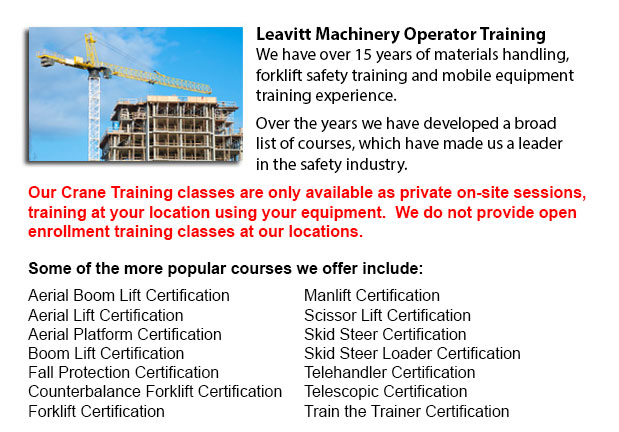
Kamloops Overhead Crane Operator Training - Our overhead crane operator training program is intended to teach employees the fundamentals of overhead crane/sling operation and pre-shift inspections. Programs are taught by our professional trainers and consultants. Well-trained employees are more efficient and productive, that saves on costs connected with property damage, product damage, and accidents because of the utilization of improper operating procedures. Our overhead crane certification is customized for staff who have literacy barriers, reducing certification time by 50 percent.
Overhead cranes are best for particular repetitive lifting activities. This type of crane has wide ranging capacities. They may be utilized for specialized lifting jobs such as installing or removing major plant machines.
To safely operate an overhead crane, workers need to employ safe rigging practices. This needs both knowledge and practice. The load must be rigged correctly to guarantee its stability when lifted. Prior to starting a hoisting job, it must be determined that the crane is suitable for the task, with appropriate travel, lift and capacity. The crane must be subjected to a thorough visual and physical inspection before utilization. The capacity of all machines, including the slings, hardware and rope, should never go over load weight capacities.
The rigger must know the right sling for every lift and check slings and other rigging hardware before using. Clear signals must be utilized in communications with the crane operator. A signaler has to be designated for the role and signals need to be agreed upon. The crane operator needs to follow instructions from the designated individual only. If a remote or wired controller is being used, the operator should be trained in all its functions.
To guarantee the safety of employees, a warning has to be issued and the path of the load should be cleared of all obstructions before the lift starts. People should not be allowed to walk beneath the lift loads. The crane hoist needs to be centered over the load prior to hoisting in order to prevent swinging. The safety catch must be closed instantly after sliding the sling entirely onto the lifting hook. Sling legs that are not utilized must be secured so they do not drag. Never leave loose materials on a load being hoisted. Watch that fingers and hands are clear when slack is taken out of a sling. Step clear of the danger zone before the lift is made.
-
Kamloops Counterbalance Forklift Training
Kamloops Counterbalance Forklift Training - Counterbalance Forklift Training courses are always in high demand. The Counterbalance forklift is a forklift which is made with a weight which counters the balance, equally spreading the weight of the load... More -
Kamloops Manlift Certification
Kamloops Manlift Certification - The Manlifts and Elevated Platforms program offers training on the rules, regulations and proper application of safe operating measures and work practices included in daily activities for people who work making use of... More -
Kamloops Boom Lift Training
Kamloops Boom Lift Training - Elevated work platforms, likewise referred to as aerial platforms, allow workers to carry out tasks at heights that will otherwise be not reachable. There are various styles of lifts designed for different site applicati... More -
Operator Safety Certification | Re-Qualification Certification | In-House Instructor Certification in Kamloops
Forklifts are used in just about all industrial construction sites and in warehouse operations and in boat yards. The reach feature of a lift truck is a vital component used in several applications like for instance when a shelving system is being us... More -
Kamloops Manlift Safety Training
Kamloops Manlift Safety Training - It is essential for competent Manlift operators to be aware of the connected dangers that come with particular kinds of scissor lifts. They must be able to operate the scissor lift in a way that protects not only th... More -
Kamloops Crane Training Schools
Kamloops Crane Training Schools - We have designed several programs for Mobile Crane Operation at our Crane Training Schools. These programs are recommended for the experienced operator who requires certification or re-certification, and for inexperi... More -
Skid Steer Loader Certification in Kamloops
The engine powered skid-steer loader consists of a rigid and small frame, outfitted together with lift arms which could attach to a lot of industrial attachments and tools to perform several labor saving jobs. Typically, skid-steer loaders are four-w... More -
Kamloops Heavy Equipment License
Kamloops Heavy Equipment License - A heavy equipment license could be acquired by taking a certification and preparation course at a private training school or a vocational school. This license would qualify you to operate various types of heavy mach... More

Forklift Certification Kamloops
TOLL FREE: 1-888-254-6157
Kamloops, British Columbia
forkliftcertificationkamloops.com/
Email Us
About Us


